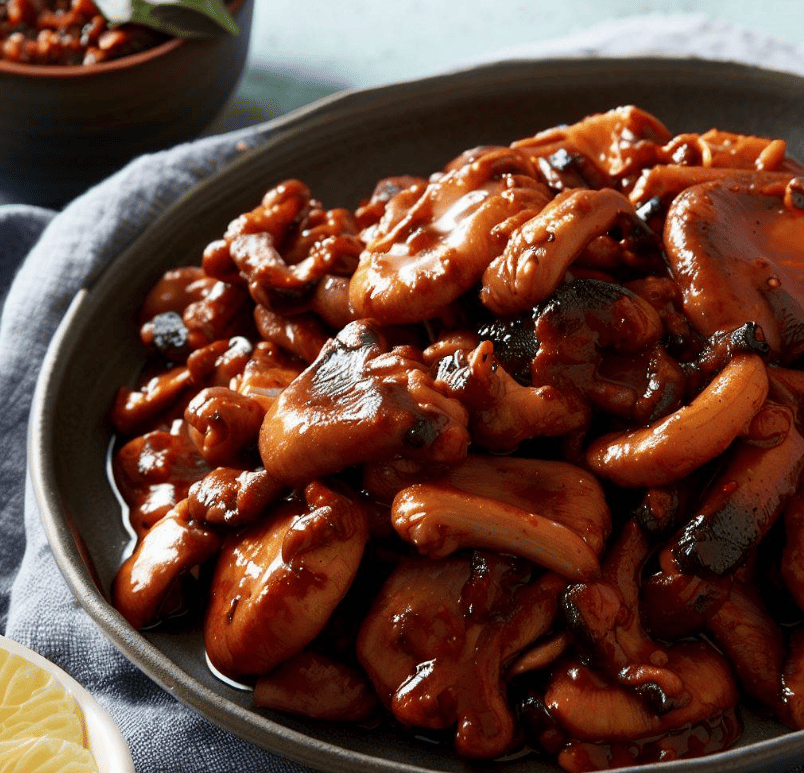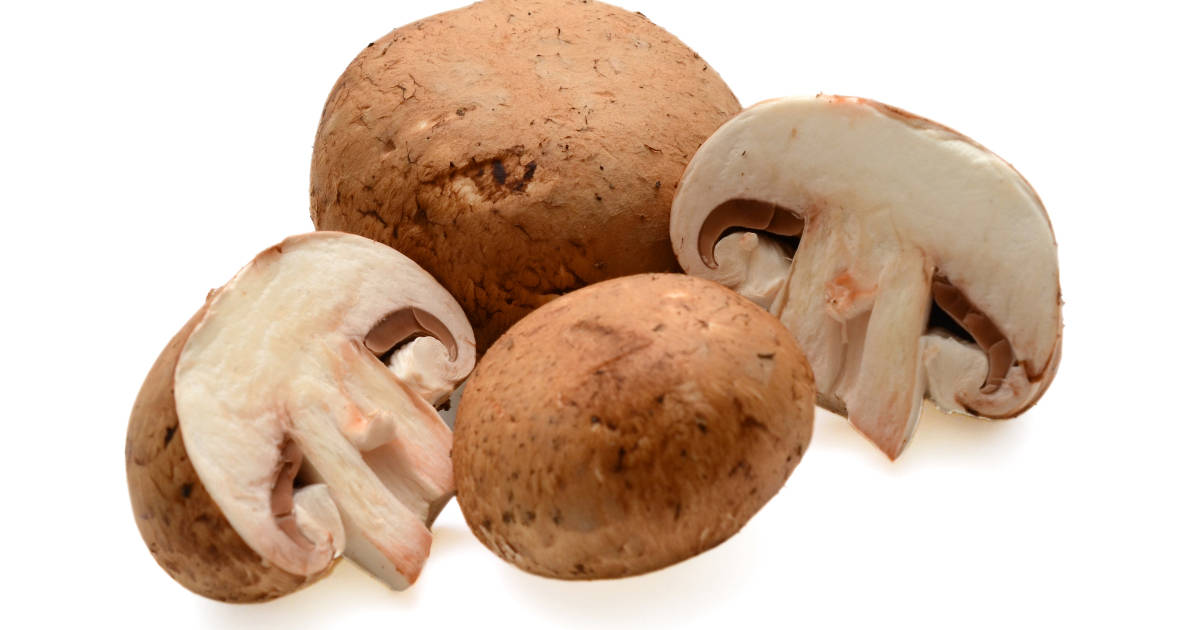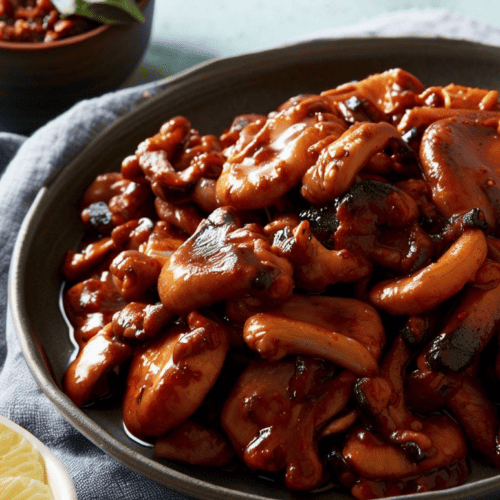Gochujang mushrooms are a delicious way to add a punch of flavor to your mushrooms with some simple pantry items. This savory gochujang mushroom recipe is the perfect side to any meal or enjoyed on its own over some rice or noodles!

Gochujang is a Korean fermented chili paste that adds a kick of spice and umami flavor to dishes. It has a unique sweet, spicy, and savory flavor profile that makes it extremely versatile to use in recipes.
Making Gochujang Mushrooms

To make gochujang mushrooms, you just need a few simple ingredients:
- Mushrooms - Baby Bellas work well, but you can use any variety. Slice them to your desired thickness.
- Gochujang - Look for it in the international aisle of your grocery store. The spiciness can vary, so taste your marinade and adjust if needed.
- Soy sauce - Use a low-sodium variety.
- Mirin - This is a Japanese sweet rice wine. Substitute rice vinegar and extra honey if you can't find it.
- Brown sugar - It adds a nice sweetness to balance the spice. Don't skip it!
- Water
- Oil - Olive or sesame oil are good options for sautéing.
- Cornstarch (optional) - For thickening the sauce.
You'll also need items like rice, green onions, and sesame seeds to serve it.
Marinate the Mushrooms in the Gochujang Sauce
Marinating the mushrooms is key for adding flavor. Here's how:
- In a bowl, whisk together the gochujang, soy sauce, mirin, brown sugar, and water.
- Add the sliced mushrooms and toss to coat.
- Let marinate for at least 10 minutes, up to overnight in the fridge.
Sear the Mushrooms
To cook gochujang mushrooms:
- In a skillet over medium heat, add oil.
- Add the mushrooms in a single layer. Let them sear untouched for 2-3 minutes per side until browned.
- Repeat with remaining mushrooms, cooking in batches if needed.
Browning the mushrooms builds great flavor.
Finish with a Glaze
To finish it off:
- Return seared mushrooms to the skillet.
- Whisk cornstarch into the reserved marinade.
- Pour the marinade into the skillet and simmer until thickened.
This leaves you with flavorful mushrooms coated in a sweet, spicy glaze!
Serving Suggestions
This versatile recipe can be customized in many ways:
- Add fresh ginger to the marinade for extra flavor.
- Mix in diced bacon, sausage, or chickpeas while cooking.
- Use king oysters or other exotic mushrooms instead of baby bellas.
- Serve with kimchi, pickled carrots, bulgogi beef, or Korean noodles.
- Make it into a rice bowl topped with a fried egg.
The possibilities are endless with gochujang mushrooms! Prepare them according to your tastes.
1. Make Gochujang Mushroom Bowls
These mushrooms also make for an easy meal prep when served over rice. To make gochujang mushroom bowls for meal prep:
- Portion rice into containers along with the mushrooms.
- Keep refrigerated for up to 4 days.
- Good rice choices are jasmine, basmati, coconut, or purple.
You can also use the gochujang mushrooms as a taco filling or in Buddha bowls, grain bowls, and more. They add a flavor punch to any meal!
2. Gochujang Udon Noodle Sauce
For an even quicker gochujang mushroom dish, make gochujang udon! The noodles cook right in the tasty sauce.
- Sauté mushrooms and garlic as normal.
- Add heavy cream, gochujang, soy sauce, and sugar. Simmer.
- Toss in cooked udon noodles to coat in sauce.
Top with scallions and sesame seeds for an easy 20-minute dinner. Add protein like shrimp if desired.
3. Sheet Pan Gochujang Tofu and Mushrooms
For an easy cleanup sheet pan meal, bake gochujang glazed tofu and mushrooms:
- Toss cubed extra firm tofu and mushrooms with the gochujang marinade.
- Spread on a parchment-lined baking sheet.
- Bake 20 minutes, stirring halfway.
Serve with massaged spinach and rice for a complete meal with minimal cleanup.
4. Gochujang Bibimbap Bowls
You can also use gochujang mushrooms in bibimbap, a colorful Korean rice bowl.
- Stir-fry mushrooms, carrots, and garlic.
- Serve over rice with fried eggs, pickled cucumbers, and gochujang sauce.
Gochujang gives this bowl an amazing flavor boost!
5. Creamy Gochujang Pasta
For a tasty pasta, make a creamy gochujang mushroom sauce:
- Sauté mushrooms and garlic.
- Add gochujang, heavy cream, pasta water, and soy sauce. Simmer.
- Toss with cooked pasta to coat.
The noodles soak up the spicy, savory sauce beautifully. Just add some parsley for freshness if desired.
6. Gochujang Shiitake Congee
For a comforting congee, use gochujang and shiitakes:
- Cook brown rice in broth until very soft, about 1.5 hours.
- Sauté garlic, ginger, and shallots. Add rice and cook briefly.
- Stir in gochujang and season with soy sauce.
- Top bowls with sliced shiitakes, lime gochujang sauce, and garnishes.
The nutty brown rice with mushroom flavor is taken to the next level by the gochujang.
7. Pickled Radish Topping
For texture, serve gochujang mushrooms with kimchi:
- Make gochujang mushrooms as desired.
- Stir together rice vinegar, sugar, and salt for a quick pickle.
- Toss thinly sliced radishes in the vinegar mixture.
- Top the mushrooms with crisp pickled radishes.
The pickled radishes cut through the rich mushrooms beautifully.
8. Use Leftover Marinade
Don't toss that leftover gochujang marinade! Use it to add flavor to:
- Stir-fries with mixed veggies
- Salad dressings
- Rice or quinoa
- Roasted potatoes
- Hummus
- Soup broths
A little goes a long way to spice things up. Get creative with leftover gochujang!
9. Adjust the Spice Level
When making the gochujang marinade:
- Taste it before adding mushrooms.
- Start with 1 Tbsp brown sugar and add more to taste.
- Add gochujang to your spice tolerance.
- For less heat, use mild gochujang or dilute with miso paste.
Tailor the marinade to your preferences. Sample before tossing with mushrooms.
10. Safety Tips
When working with raw mushrooms:
- Clean mushrooms well before using.
- Ensure mushrooms are cooked through until very tender.
- Discard any that look slimy or spoiled.
- Refrigerate leftovers within 2 hours.
Proper cooking and handling prevent the risk of bacteria or microbes. Cook gochujang mushrooms thoroughly.
11. Veggie Packed Stir-Fry
Bulk up your mushrooms into a veggie-packed stir-fry:
- Sauté an assortment of vegetables like peppers, greens, snap peas, etc.
- Add gochujang mushrooms toward the end to warm through.
- Serve over cauliflower rice for a low-carb option.
Pile your plate with saucy gochujang mushrooms and crisp-tender veggies for a satisfying and healthy plant-based meal.
12. Whole Grain Bowl Base
For the healthiest meal, serve gochujang mushrooms over whole grains:
- Quinoa, farro, or barley offer a tasty nutty flavor.
- Brown rice provides fiber.
- Heat up some leftover whole grain to use it up.
- Add veggies like edamame or sautéed greens.
The whole grains paired with gochujang mushrooms make both a filling and well-balanced meal.
13. Easy Flavor Booster
Gochujang and mushrooms are a match made in flavor heaven. When you need a quick flavor boost:
- Add gochujang and sautéed mushrooms to:
- Fried rice
- Noodle bowls
- Soup broths
- Stir-fries
- Casserole bakes
- Eggs
It takes basic ingredients from boring to bold instantly. Keep gochujang and mushrooms on hand for an easy flavor infusion anytime.
14. Appetizer Bites
These flavorful mushrooms also make a great appetizer or snack:
- Serve small plates of gochujang mushrooms with toothpicks.
- Stuff them into wonton wrappers for crispy bites.
- Add to lettuce wraps or rice paper rolls.
- Roast them into crunchy mushroom chips.
Gochujang mushrooms are sure to be a hit at your next party or gathering. Keep extras on hand for snacking anytime.
15. Versatile Leftovers
Leftover gochujang mushrooms are extremely versatile:
- Add to grain bowls, Buddha bowls, or mason jar salads.
- Stuff into lettuce wraps, sandwiches, or pitas.
- Mix with riced cauliflower as taco or burrito filling.
- Toss into pasta dishes for a flavor punch.
- Blend into hummus for a spicy twist.
Get creative with leftover gochujang mushrooms in endless quick and easy meals throughout the week. They even make great breakfast skillet scrambles!
16. Make It Vegan
To keep gochujang mushrooms plant-based and vegan:
- Use vegetable or mushroom broth instead of chicken.
- Swap the oil for a vegan-friendly option like avocado oil.
- Omit optional ingredients like honey or fish sauce.
- Serve over cauliflower rice instead of white rice.
With just a few simple swaps, anyone can enjoy the amazing flavors of gochujang mushrooms. They are endlessly adaptable to suit all diets and tastes!
FAQ
What are some good mushroom varieties to use in gochujang mushroom recipes?
While most recipes call for button or cremini mushrooms, you can also use shiitake, oyster, maitake, beech, or king oyster mushrooms. Meaty portobello mushrooms are great too. Mix up varieties for more texture and visual appeal.
What can I serve with gochujang mushrooms?
These versatile mushrooms pair well with rice, quinoa, noodles, roasted vegetables, salads, eggs, tofu, lean proteins, and more. Get creative with grain bowls, buddha bowls, tacos, sandwiches, flatbreads, and stir-fries.
How long does the gochujang marinade need to sit?
For the quickest option, marinate mushrooms for 10 minutes. For more flavor, marinate up to overnight in the fridge. Stir occasionally as marinating.
Can I make gochujang mushrooms gluten-free?
Yes! Use tamari instead of soy sauce and gluten-free gochujang. Serve over cauliflower rice or quinoa instead of wheat noodles.
Can I adjust the spice level of the gochujang?
Absolutely. Taste your marinade and adjust brown sugar and gochujang to your desired spice level. For less heat, use mild gochujang or add some miso paste.
Conclusion
As you can see, gochujang mushroom recipes are endlessly adaptable to suit any taste or dietary needs. The sweet-spicy Korean flavor of gochujang pairs perfectly with the savory umami hit of mushrooms. From weeknight rice bowls to party appetizers, these tasty mushrooms are sure to be a new favorite.
So get creative in the kitchen with gochujang and mushrooms! Merge Korean and Japanese flavors by pairing them with rice and noodles. Load them into tacos and sandwiches for a flavor punch. Roast them into crispy, addictive snacks. However you choose to enjoy them, gochujang mushrooms are a foolproof way to add big, bold flavor to your cooking.

Sweet and Spicy Gochujang Mushrooms
Ingredients
- 1 lb mushrooms, sliced
- 3 Tbsp gochujang (Korean chili paste)
- 2 Tbsp soy sauce or tamari
- 2 Tbsp brown sugar
- 1 Tbsp rice vinegar
- 1 Tbsp vegetable oil
- 1 tsp sesame oil
- 2 cloves garlic, minced
- 1 tsp cornstarch (optional, for thickening sauce)
Instructions
- In a bowl, whisk together the gochujang, soy sauce, brown sugar, rice vinegar, and 2 Tbsp water. Add sliced mushrooms and let marinate 10 minutes up to overnight.
- Heat oil in a skillet over medium high heat. Add mushrooms in a single layer and cook undisturbed for 2-3 minutes per side until browned. Work in batches if needed.
- Return all mushrooms to skillet and add garlic. Cook 1 minute until fragrant.
- Whisk cornstarch into marinade and add to skillet. Cook until thickened to a glaze. Remove from heat and stir in sesame oil.
- Serve mushrooms over rice, noodles, in sandwiches or wraps, or enjoy as a snack! Store leftovers refrigerated up to 4 days.

